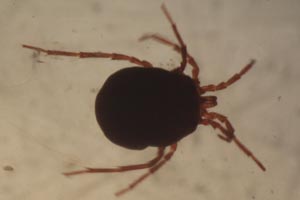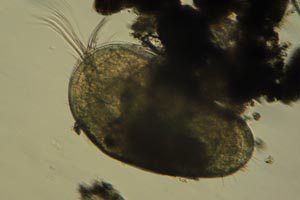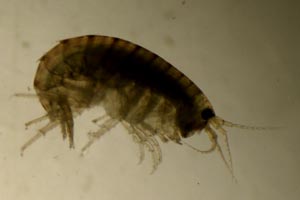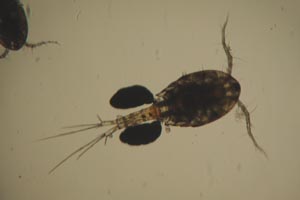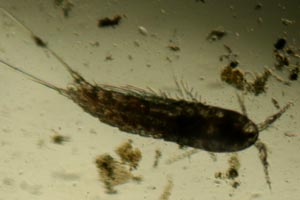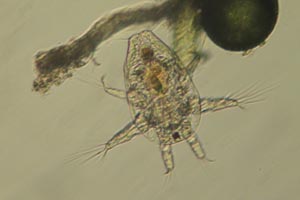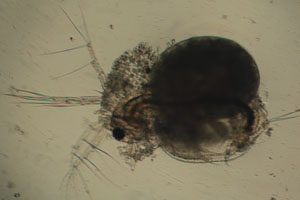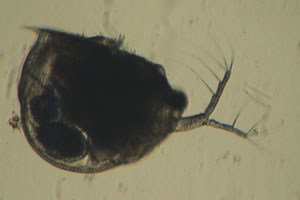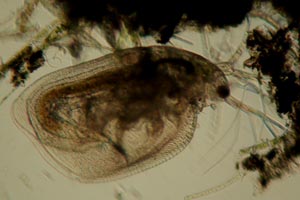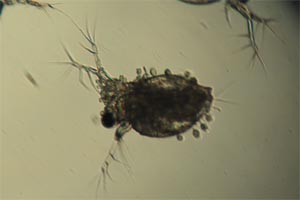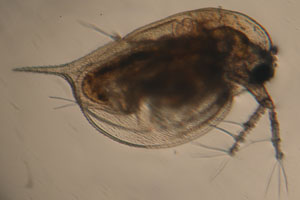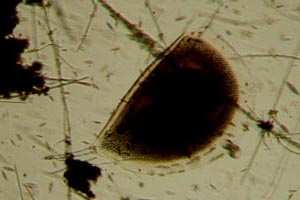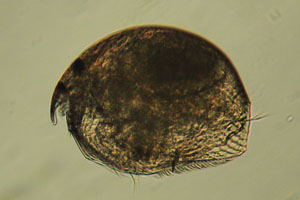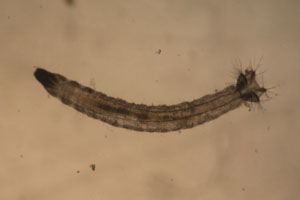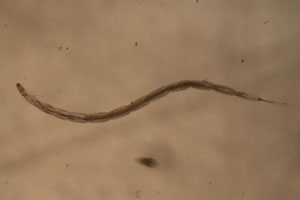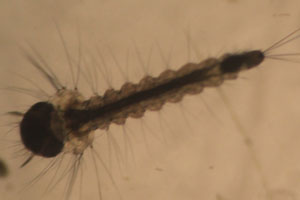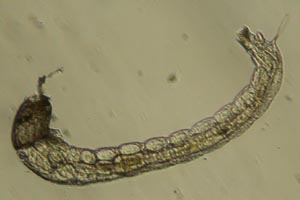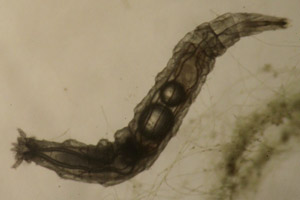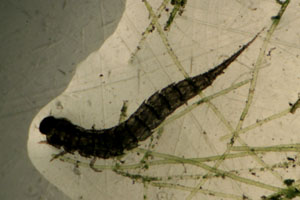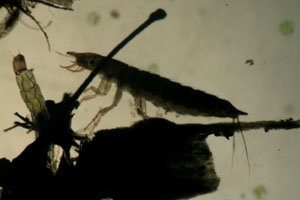Microlife: Insects, crustaceans & allies
Kingdom Animalia, Phylum Arthropoda
Arthropods occur in nearly every terrestrial and aquatic habitat. All of them share a segmented body plan with paired appendages. The cuticle is molted repeatedly during growth, and in adults usually forms an exoskeleton with hardened plates, although larvae sometimes have softer bodies.
The appendages usually take the form of mouthparts or sensory antennae near the front, and legs or gills further back. In many aquatic types they are biramous, i.e. divide into two branches, while terrestrial kinds normally have uniramous appendages. The exact arrangement varies considerably from one class to another.
Class Arachnida
Arachnids are mainly terrestrial arthropods like spiders, scorpions, and harvestmen, with bodies divided into a cephalothorax and abdomen. The former typically has two pairs of feeding appendages and four pairs of legs, all uniramous, and the latter only reduced appendages. They have no antennae and usually simple eyes.
Acariformes
Greek akari, mite
Angl. AK-a-ri-FOR-meez
Acariformes include most mites, small arachnids where the cephalothorax and abdomen are fused. Most are terrestrial or parasitic, but one large group are aquatic, called water mites.
These are usually red or other bright colours. Typically adults prey on other arthropods while larvae, which have six legs, parasitize flying insects and their aquatic young.
Class Ostracoda
Crustaceans include most aquatic arthropods. Some grow over a metre in size, but many are only a few millimetres long. All have a fused head with four antennae and a segmented trunk, often divided into a thorax and abdomen. Except the first antennae, the appendages are usually biramous.
Ostracods have a large carapace divided into two valves, which enclose the body and limbs on either side. Most are small filter-feeders. The young are nauplius larvae with one eye and six limbs, a type found in many crustaceans; here they usually have a bivalved carapace as well.
Podocopida
Greek pous, foot, kōpē, handle or oar
Angl. POD-o-KOP-i-da
Podocopids have one eye, no heart, and often an indented margin. They are mainly benthic crawlers or swimmers, and include all freshwater ostracods.
Class Malacostraca
Malacostraca include most of the larger crustaceans like shrimps and crabs, as well as terrestrial kinds like woodlice. They usually have two compound eyes, often on stalks, and many have a protective carapace. The thorax has 8 segments, with appendages for feeding or movement, and the abdomen typically has 6 with appendages for paddling.
Amphipoda
Greek amphi, on both sides, pous, foot
Angl. am-FIP-o-da
Amphipods have no carapace or eyestalks and most have narrow bodies. The thorax has 8 uniramous legs directed forward and 6 directed backward.
Class Copepoda
Copepods are mainly small aquatic or parasitic crustaceans. They typically have a head shield with one eye and four or five pairs of thoracic legs, used for crawling and swimming. The abdomen ends in a pair of appendages called caudal rami, and in females may carry one or two egg clusters.
Cyclopoida
Greek kyklōps, cyclops
Angl. SYE-klo-POY-da
Cyclopoids are most common near shorelines. They have a broad head and thorax, with first antennae about as long as the two together, and a narrow abdomen.
Harpacticoida
Greek harpax or harpaktēs, robber
Angl. har-PAK-ti-KOY-da
Harpacticoids have a small head, about as wide as the body, and relatively short antennae. They occur mainly as benthos in still water.
Larvae: Copepoda
Copepods have nauplius larvae with two uniramous and four biramous limbs, with the branches longer than the bases. They undergo several moults before becoming adults.
Class Branchiopoda
Branchiopoda are smaller crustaceans with paddle-like legs. The most common are cladocerans or water fleas, which have a folded carapace that typically encloses the trunk but not head. This also serves as a chamber for the eggs or young. Most live in freshwater, with no larval stage and only small seasonal males.
Water fleas usually have one compound eye, sometimes accompanied by a simple ocellus, and large branched second antennae used in swimming. In Anomopoda the latter have a relatively small base and few bristles or setae, with three at each end.
Moinidae
After Moina in Macpherson’s The Poems of Ossian
Angl. MOY-ni-dee
Moinids have first antennae longer than their eye and attached below it by movable joints. The head is rounded, with no beak. They are most common in small pools.
Scapholeberis
Greek skaphē, trough or boat, lebēris, husk
Angl. SKAF-o-le-BEER-is
Scapholeberis have a stright ventral margin that ends in a spine on each carapace edge, adapted to hanging on the surface. The head has a small beak with only short first antennae.
Simocephalus
Greek simos, snub-nosed, kephalē, head
Angl. SYE-mo-SEF-a-lus
Simocephalus have a broad head with a low beak and steep forehead, so its front margin looks squared off. The body is usually truncated to bluntly pointed.
Ceriodaphnia
Greek kērion, honeycomb, with Daphnia
Angl. SEER-eeo-DAF-neea
Ceriodaphnia have a rounded head with short first antennae, smaller than the eye. The upper back has a notch and some have a slight point at the posterior.
Daphnia
After Daphnē of Greek myth
Angl. DAF-neea
Daphnia have a downward beak but the forehead is curved or crested. The back does not have a notch, and after the first moult extends into a long posterior spine.
Ephippia: Daphnia
In poor conditions water fleas produce resting eggs, enclosed in protective cases called ephippia. These are usually fertilized and later hatch to release new females.
Daphnia have semicircular ephippia, usually with two eggs. Their odd shape reflects the mother’s straight back and spine.
Ilyocryptus
Greek ilys, mud, kryptos, hidden
Angl. IL-eeo-KRIP-tus
Ilyocryptus have a steep head with long first antennae attached in its middle. The carapace is often reddish or dirt-covered, enclosing an abdomen with a spiny posterior margin.
Chydoridae
Etymology unclear
Chydorids have short antennae, with the second pair held near the body and the first under the small pointed head. They are mainly benthic and often use the abdomen in crawling.
Class Collembola – springtails
Hexapods have uniramous appendages, with no second antennae and only 6 thoracic legs. The abdomen often has posterior projections but otherwise at most reduced appendages. Aside from the insects proper, these include a few groups where the mouthparts are concealed in an oral pouch, of which springtails are most common.
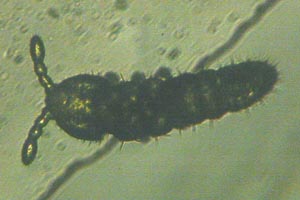
Wet garden dirt - unrecorded size
Springtails have abdomens with up to 6 segments and often a posterior furcula, tucked underneath as a spring for jumping. Most live in soil and litter but they may even occur on water.
Class Insecta
Insects are hexapods with exposed mouthparts, usually two compound eyes, and up to 11 visible abdominal segments. Many adults also have paired wings on the back two thoracic segments. They are some of the only flying life, common in nearly all habitats except oceans and with far more described species than all other groups.
Many groups of insects undergo complete metamorphosis, with an inactive pupal stage separating the larvae from adults, which have little resemblance. Several families of Diptera or flies have aquatic larvae, which are long and lack jointed legs though they often have simpler prolegs or hooks.
Larvae: Limoniidae
Greek leimōn, meadow
Angl. LYE-mo-NYE-i-dee
Crane fly larvae have a small head and several pairs of prolegs. There are usually lobes surrounding spiracles at the tail end, with at most five in the small Limoniidae.
Larvae: Ceratopogonidae – biting midges
Greek keras, horn, pōgōn, beard
Angl. SER-a-to-po-GON-i-dee
Biting midge larvae are usually long and very thin with no prolegs, though some are exceptions. The body is divided into similar segments, with a distinct head but not thorax or abdomen.
Larvae: Culicidae – mosquitoes
Latin culex, gnat or midge
Angl. kyoo-LIS-i-dee
Mosquito larvae have a broad fused thorax and narrower abdomen. The body segments have bundles of setae, and there are also shorter brushes on the head.
Larvae: Simuliidae – black flies
Perhaps Latin simulare, to copy or feign
Angl. SIM-yu-LYE-i-dee
Black fly larvae have a broad abdomen with a posterior ring that anchors them in place. The mouthparts are often fan-like, and there is one fleshy proleg behind the head.
Larvae: Chironomidae – true midges
Greek cheir, hand, nomos, custom
Angl. KYE-ro-NOM-i-dee
Midge larvae have two pairs of prolegs, one behind the head and one at the posterior. They can swim by rapidly flicking their head and tail, but may also be found in tubular cases.
Larvae: Sciomyzidae – marsh flies
Greek skia, shade, myzein, to suck
Angl. SYE-o-MIZ-i-dee
Sciomyzid larvae are wrinkled with posterior spiracles and lobes, but no defined head or prolegs. Instead the front is pointed and retractable. Nearly all feed on snails.
Coleoptera or beetles include several families that are mainly aquatic as both adults and larvae. The latter typically have jointed legs and biting or chewing mouthparts. The abdomen sometimes has simple appendages or projections but not annulated filaments or prolegs as found in other groups.
Larvae: Haliplidae – crawling water beetles
Greek hals, sea or salt, ploos or plous, sailing
Angl. ha-LIP-li-dee
Haliplid larvae are thin with one or two long posterior filaments. The abdomen has 9-10 segments and each foot has a single claw. Like the adults they feed mainly on plants or algae.
Larvae: Dytiscidae – diving beetles
Greek dytēs, diver, -iskos, dimn.
Angl. di-TIS-i-dee
Dytiscid larvae are predators with sickle-shaped mandibles. The abdomen has 8 segments with two posterior projections and the feet each have two claws.
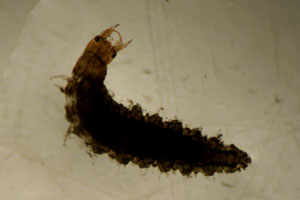
Spring puddle - about 6.2 mm
Larvae: Hydrophilidae – water scavenger beetles
Greek hydōr, water, philos, friend
Angl. HYE-dro-FIL-i-dee
Hydrophilid larvae have large projecting mandibles with teeth. The antennae and legs are relatively short and the abdomen has 8-9 segments without terminal appendages.
These are again predatory but whereas diving beetles remain so, here the adults are mainly scavenging omnivores.
